White Mosque on the Night of Decree
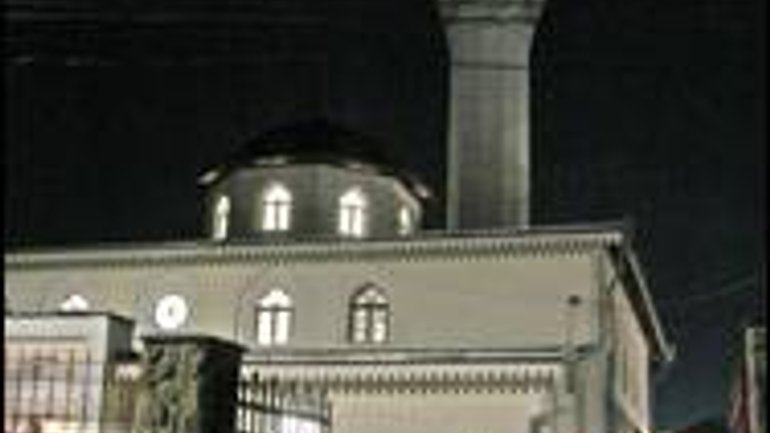
The Kebir-Jami assembly mosque (Simferopol, 4 Kurchatova Street) was erected in 1508, which is written in the Arabic inscription above the entrance. However, the modern studies of restorers allow one to assume an earlier date, 1502. The mosque also included an educational institution, a madrasah. That building, located at 8 Samokysha Street, has also been preserved. Today a Crimean Tatar library is located there.
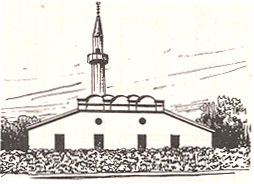 Originally, the basilica-like worship building had a rectangular layout of 9 by 12 meters (even though, according to another version, the mosque originally had a cupola layout of 7 by 7 meters) with an entrance from the north, a niche in the southern wall, and a separate minaret. Its outward appearance was ascetically modest and scanty: no profiles or other decorations except a tablet saying that the mosque was built by Abdurakhman-bek-Ali to the glory of Khan Sultan-Mengli-Girey in the month of Mukharel, 914 (1508). In order to diversify the facades, the ancient master used two versions of an arrangement of windows: rectangular in the lower tier and rounded upstairs. The three-slope tiled roof and a short minaret made of roughly-cut stones with a simple balcony and a conic ending crowned with a crescent also contributed to the picturesque character of the composition.
Originally, the basilica-like worship building had a rectangular layout of 9 by 12 meters (even though, according to another version, the mosque originally had a cupola layout of 7 by 7 meters) with an entrance from the north, a niche in the southern wall, and a separate minaret. Its outward appearance was ascetically modest and scanty: no profiles or other decorations except a tablet saying that the mosque was built by Abdurakhman-bek-Ali to the glory of Khan Sultan-Mengli-Girey in the month of Mukharel, 914 (1508). In order to diversify the facades, the ancient master used two versions of an arrangement of windows: rectangular in the lower tier and rounded upstairs. The three-slope tiled roof and a short minaret made of roughly-cut stones with a simple balcony and a conic ending crowned with a crescent also contributed to the picturesque character of the composition.
The walls of the mosque were made with the use of clay mortar and painted with a limestone solution. It was the regularly-renewed whiteness of the walls that determined the name of the temple, Ak-Mechet (White Mosque), and then of the Tatar settlement bearing the same name.
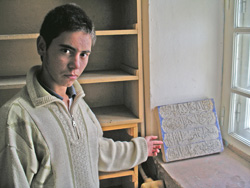 In the first half of the 18th century, the mosque suffered a fire and was renewed in 1772 and its northern part was extended. At the beginning of the 20th century (1907), the temple underwent major repair and was enlarged. As a result, its volume-space composition changed and became more complicated: After side naves were added, the minaret found itself inside of one of them and a developed cornice, decorated with finery, appeared on the northern facade. After the primitive reconstructions and enlargements, the building assumed the status of a mosque for assemblies (Kebir-Jami), almost a square layout and a bazaar-like appearance, in which lies its originality.
In the first half of the 18th century, the mosque suffered a fire and was renewed in 1772 and its northern part was extended. At the beginning of the 20th century (1907), the temple underwent major repair and was enlarged. As a result, its volume-space composition changed and became more complicated: After side naves were added, the minaret found itself inside of one of them and a developed cornice, decorated with finery, appeared on the northern facade. After the primitive reconstructions and enlargements, the building assumed the status of a mosque for assemblies (Kebir-Jami), almost a square layout and a bazaar-like appearance, in which lies its originality.
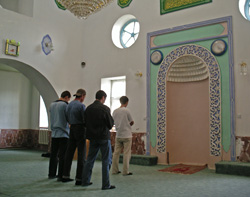 However, the extensions and renewed appearance could not help Kebir-Jami to become a really leading assembly mosque as compared to new mosques, built in the town in the 19th century, which were more attractive or located closer to the places of residence of the faithful. As of the end of the 19th century, there were at least ten of them in the town.
However, the extensions and renewed appearance could not help Kebir-Jami to become a really leading assembly mosque as compared to new mosques, built in the town in the 19th century, which were more attractive or located closer to the places of residence of the faithful. As of the end of the 19th century, there were at least ten of them in the town.
But the modest old Kebir-Jami was destined to play a responsible role: it became the main distinguishing element of the former medieval settlement Ak-Mechet. The shortest paths from residential areas, which grew up around it like crystals in a concentrated solution sticking to each other and covering the plateau, met exactly at the mosque and adjoining big squares, Worship Square, Market Square, and Water-Collection Square.
Later, after the annexation of Crimea to Russia, at the vacant places near Kebir Jami Orthodox churches appeared: the Church of Constantine and Helen first, and then the Cathedral of Sts. Peter and Paul , the Greek Church of the Holy Trinity, and others.
After World War II, Kebir-Jami was in a state of neglect and redesign. For a long time, a book-cover workshop was located there. After the return of the Crimean Tatars from deportation, a new revival of the old mosque began: in 1989 the mosque was given back to the Muslim community.
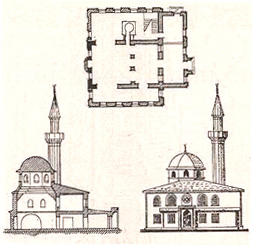 After a thorough study of the monument by experts of the Crimean Complex Architectural-Restoration Workshop Institute, Ukrproektrestavratsiia, and a complex examination of its condition, it was decided to build new walls on the old foundations with the use of strong cement-sand mortar and modern reinforced concrete structures. Only an old fragment of a wall with a niche was left: it was built into the southern facade of the new temple. Its design was developed by the following experts of the workshop: architects A. Abdurakhmanov and S. Khalilov and engineer L. Opanasenko. The construction was implemented by the Crimean Restoration Department and Turkish masters by order of the Crimean Inspection of Architectural Monuments.
After a thorough study of the monument by experts of the Crimean Complex Architectural-Restoration Workshop Institute, Ukrproektrestavratsiia, and a complex examination of its condition, it was decided to build new walls on the old foundations with the use of strong cement-sand mortar and modern reinforced concrete structures. Only an old fragment of a wall with a niche was left: it was built into the southern facade of the new temple. Its design was developed by the following experts of the workshop: architects A. Abdurakhmanov and S. Khalilov and engineer L. Opanasenko. The construction was implemented by the Crimean Restoration Department and Turkish masters by order of the Crimean Inspection of Architectural Monuments.
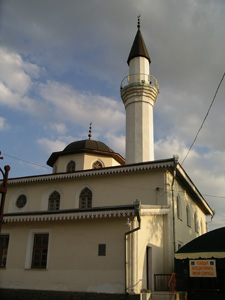 The present appearance of the mosque is an example of Turkish worship architecture. The three-nave prayer hall with a narthex, women’s wings, and a minaret located in the western nave, is crowned with semi-spherical cupolas on a high eight-sided drum with gabled windows at all sides. The authors diversified the facades with combinations of windows: rectangular in the lower tier and gabled and rounded upstairs. The segmentation of the layout of the renewed temple reflects the building stages of the reconstructions and extensions.
The present appearance of the mosque is an example of Turkish worship architecture. The three-nave prayer hall with a narthex, women’s wings, and a minaret located in the western nave, is crowned with semi-spherical cupolas on a high eight-sided drum with gabled windows at all sides. The authors diversified the facades with combinations of windows: rectangular in the lower tier and gabled and rounded upstairs. The segmentation of the layout of the renewed temple reflects the building stages of the reconstructions and extensions.
The Kebir-Jami Mosque cannot house more than 200 faithful, therefore celebrations attended by 2000 or so Muslims have to be held outdoors or in rented gymnasiums. In view of the above, the Spiritual Direction of the Muslims of Crimea has approached Simferopol authorities with the request to allocate a lot for the construction of a new assembly mosque for more than five years now, but the problem is still unresolved.
***
The mosque was not crowded on 8 October this year, though. During the day, people came in and out to pray. A local boy explained: on weekdays, when most Muslims are busy working at secular institutions, the faithful are allowed to come for prayer not at strictly defined hours but when circumstances permit. “Come in the evening, after sunset, it will be more interesting then,” he invited.
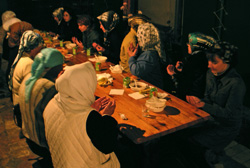 This was right. A few dozen people who had fasted diligently during the day came to a spacious tent for a joint supper. Men and women sat at separate tables. Several boys distributed the food: shurpa (meat soup), meat and onion pies, bread, a banana, and juice.
This was right. A few dozen people who had fasted diligently during the day came to a spacious tent for a joint supper. Men and women sat at separate tables. Several boys distributed the food: shurpa (meat soup), meat and onion pies, bread, a banana, and juice.
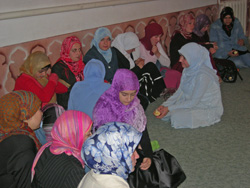 After supper, the faithful went to the mosque. Men gathered downstairs and women on the first floor, which resembled a krylos (wing) in a Christian church. Some of them wore traditional long cloths enveloping the whole body including the head and leaving only the face uncovered. According to custom, women are to dress modestly and “not to stand out.” Nowadays, though, women dressed in that way are perhaps too eye-catching.
After supper, the faithful went to the mosque. Men gathered downstairs and women on the first floor, which resembled a krylos (wing) in a Christian church. Some of them wore traditional long cloths enveloping the whole body including the head and leaving only the face uncovered. According to custom, women are to dress modestly and “not to stand out.” Nowadays, though, women dressed in that way are perhaps too eye-catching.
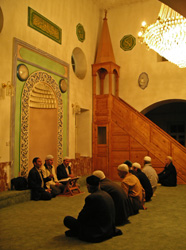 Unlike the women, the men sat on the floor in straight rows. During prayer, bows and the sermons of the mullah alternated with rather monotone but melodic singing. Apparently, the prayer of the Night of Decree was really an extraordinary phenomenon: it was diligently filmed by a local Tatar journalist.
Unlike the women, the men sat on the floor in straight rows. During prayer, bows and the sermons of the mullah alternated with rather monotone but melodic singing. Apparently, the prayer of the Night of Decree was really an extraordinary phenomenon: it was diligently filmed by a local Tatar journalist.
Excerpts from the following books were used: “Monuments of Crimean Tatar architecture,” by Y, Krykun and “Art of the Tatars of the Crimea” by S. Chervona. Photos by Taras Hrynchyshyn.
RISU’s Ukrainian-language site posted the story of Elzara Abduramanova and Taras Hrynchyshyn on 25 October 2007.
See more photos on RISU’s Ukrainian-language site:
reference source used for English text:
• http://en.wikipedia.org/wiki/Ramadan









